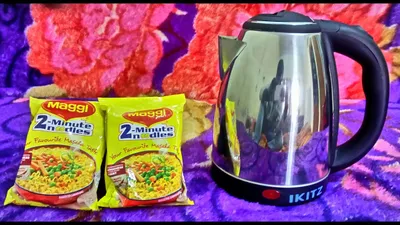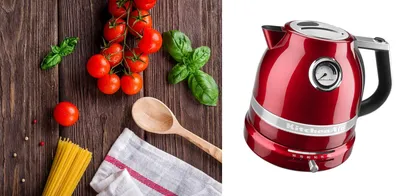The Ultimate Guide: What to Check When Buying an Electric Kettle
Discover the essential features to look for when purchasing an electric kettle. From capacity and materials to safety features and design, learn how to choose the perfect kettle for your needs.

Table of Contents
- Introduction
- The Evolution of Electric Kettles
- Key Factors to Consider When Buying an Electric Kettle
- Environmental Considerations in Kettle Selection
- Health and Safety Aspects of Different Kettle Materials
- Top Electric Kettle Recommendations
- Material Comparison
- Advanced Features in Modern Electric Kettles
- How to Test Your New Electric Kettle
- Kettle Maintenance and Longevity Tips
- FAQs About Buying Electric Kettles
- Conclusion
Electric kettles have become an indispensable kitchen appliance, offering convenience and efficiency in boiling water for various purposes. This comprehensive guide will help you navigate the key features to consider when selecting the perfect electric kettle for your needs.
Introduction
The humble electric kettle has come a long way since its invention in the late 19th century. Today, it’s a staple in kitchens worldwide, valued for its speed, efficiency, and versatility.
Electric kettles have revolutionized our kitchens, making hot water preparation quicker and more convenient than ever before. Whether you’re a tea enthusiast, coffee lover, or simply need hot water for cooking, choosing the right electric kettle can significantly enhance your daily routine.
The Evolution of Electric Kettles
Understanding the evolution of electric kettles can help appreciate modern features:
- 1891: First electric kettle invented, took 12 minutes to boil water
- 1922: Introduction of the first fully automatic electric kettle
- 1950s: Plastic kettles become popular due to their affordability
- 1980s: Introduction of cordless models with separate bases
- 2000s onwards: Smart kettles with temperature control and WiFi connectivity
This progression has led to the diverse range of electric kettles available today, catering to various needs and preferences.
Key Factors to Consider When Buying an Electric Kettle
1. Power and Efficiency
- Look for kettles with appropriate wattage (typically 1500-3000W)
- Higher wattage generally means faster boiling times
- Consider energy efficiency ratings for long-term savings
Energy efficiency is crucial not only for reducing electricity bills but also for minimizing environmental impact. Look for kettles with energy-saving features like auto shut-off and quick boil technology.
2. Capacity
Choose a capacity that suits your needs:
| Capacity Range | Ideal For | Average Boiling Time |
|---|---|---|
| 0.5L - 1L | Single users or small households | 2-3 minutes |
| 1L - 1.5L | Average families | 3-4 minutes |
| 1.5L - 2L | Large families or frequent entertainers | 4-5 minutes |
For travel options, check our guide on foldable electric kettles.
3. Material and Build Quality
Different materials offer various benefits:
- Stainless Steel: Durable, easy to clean, and maintains heat well
- Glass: Allows visibility of water level and boiling process, aesthetically pleasing
- BPA-free Plastic: Lightweight, affordable, and often available in various colors
- Ceramic: Excellent heat retention, eco-friendly, but heavier and more fragile
Learn more about kettle materials comparison.
4. Safety Features
Essential safety features include:
- Automatic shut-off
- Boil-dry protection
- Cool-touch exterior
- Secure lid lock
- Non-slip base
- Concealed heating element
For more on kettle safety, read our article on kettle safety ratings.
5. Temperature Control
- Variable temperature settings for different beverages (ideal for various tea types and coffee)
- Keep-warm function for maintaining desired temperature
- Digital display for precise temperature readings
Explore our guide on variable temperature kettles for more options.
6. Design and Ergonomics
Consider:
- Cordless design for easy pouring
- 360-degree rotational base
- Comfortable, heat-resistant handle
- Easy-to-read water level indicator
- Wide opening for easy cleaning
- Spout design for precision pouring
7. Additional Features
- Built-in water filters for improved taste
- Gooseneck spout for precision pouring (great for coffee enthusiasts)
- LED indicators for clear visibility
- Quick boil functionality
- Noise reduction technology
Environmental Considerations in Kettle Selection
When choosing an electric kettle, consider its environmental impact:
- Energy Efficiency: Look for models with high energy efficiency ratings
- Durability: Choose kettles built to last to reduce electronic waste
- Recyclable Materials: Opt for kettles made from recyclable materials like stainless steel
- Water Efficiency: Consider kettles with minimum fill lines to avoid wasting water
- Manufacturing Process: Research brands committed to sustainable manufacturing practices
For eco-friendly options, explore our guide on ceramic electric kettles, which are often more durable and environmentally friendly.
Health and Safety Aspects of Different Kettle Materials
Understanding the health implications of kettle materials is crucial:
| Material | Health Considerations | Safety Aspects |
|---|---|---|
| Stainless Steel | Generally inert, no leaching | Heat-resistant, durable |
| Glass | No chemical leaching, easy to see cleanliness | Can be fragile, potential for breakage |
| BPA-free Plastic | Ensure it’s truly BPA-free, potential for other chemicals | Lightweight, less risk of burns if dropped |
| Ceramic | Natural material, no chemical concerns | Heavy, can retain heat longer |
Always ensure your chosen kettle complies with relevant safety standards and certifications.
Top Electric Kettle Recommendations
Best Small Capacity: CHACEEF 350ml Portable Kettle
- Ideal for travel
- Temperature indicator
- Non-stick coating
- Keep-warm function
Best Medium Capacity: Amazon Basics 1 Liter Stainless Steel Kettle
- Fast boiling
- Auto shut-off feature
- Stainless steel construction
- Affordable price point
Best Large Capacity: Mueller Ultra Kettle 1.8 Liter
- Stylish borosilicate glass design
- Large 1.8L capacity
- Rapid boiling technology
- LED light indicators
Material Comparison
Stainless Steel: Comfee 1.7L Electric Tea Kettle
- Food-grade 304 stainless steel
- Cool-touch handle
- Auto shut-off and boil-dry protection
BPA-Free Plastic: Ovente 1.7 Liter Electric Kettle
- Affordable
- Various color options
- Easy to clean design
Glass: Ovente 1.5 Liter Glass Electric Kettle
- Borosilicate glass construction
- Fast boiling
- Visually appealing water boiling process
Advanced Features in Modern Electric Kettles
1. Precision Temperature Control
The Chefman Electric Kettle with Removable Tea Infuser offers:
- 5 preset temperatures
- Ideal for various tea types
- Removable tea infuser
2. Gooseneck Design for Pour-Over Coffee
COSORI Gooseneck Kettle with Temperature Control features:
- Precise pouring control
- 5 temperature presets
- Perfect for coffee enthusiasts
3. Multi-Functional Design
Cuisinart 1.7-Liter Electric Kettle offers:
- 6 preset heat settings
- Keep-warm function
- Memory feature for last used temperature
How to Test Your New Electric Kettle
Once you’ve purchased your kettle, follow these steps to ensure it’s working correctly:
- Initial Cleaning: Boil water and discard it 2-3 times before first use
- Speed Test: Time how long it takes to boil a full kettle
- Noise Level: Assess the noise during operation
- Temperature Accuracy: If applicable, test temperature presets
- Pouring Test: Check for any leaks or drips while pouring
- Safety Feature Check: Test auto shut-off and boil-dry protection
Kettle Maintenance and Longevity Tips
To ensure your kettle lasts as long as possible:
- Regular Descaling: Descale every 1-3 months depending on water hardness
- Proper Storage: Store in a dry place, avoid leaving water inside
- Gentle Cleaning: Use soft cloths and mild detergents for cleaning
- Avoid Overfilling: Respect minimum and maximum water levels
- Cord Care: Avoid wrapping the cord tightly around the base
For detailed cleaning instructions, see our guide on how to clean an electric kettle.
FAQs About Buying Electric Kettles
-
Q: How long should an electric kettle last? A: With proper care, a quality electric kettle should last 2-5 years.
-
Q: Are expensive electric kettles worth it? A: Higher-priced models often offer better durability, more features, and improved energy efficiency.
-
Q: Can electric kettles be used for more than just boiling water? A: Yes, some can be used for cooking various foods.
-
Q: How do I clean and maintain my electric kettle? A: Regular descaling and cleaning are important. Learn how to clean an electric kettle for best practices.
-
Q: Are smart kettles worth the investment? A: Smart kettles can offer convenience through features like remote operation and precise temperature control. Check our guide on best smart kettles for more information.
Conclusion
Choosing the right electric kettle involves considering various factors such as capacity, material, safety features, and additional functionalities. By focusing on your specific needs and preferences, you can select a kettle that not only boils water efficiently but also enhances your overall kitchen experience.
Remember to consider long-term factors like energy efficiency and durability alongside immediate needs like capacity and speed. With the right electric kettle, you can enjoy perfectly heated water for your tea, coffee, or cooking needs with ease and convenience.
The evolution of electric kettles has brought us a wide range of options to suit every need and preference. From basic models that simply boil water to advanced kettles with precision temperature control and smart features, there’s a kettle out there for everyone. By carefully considering the factors outlined in this guide, you can make an informed decision that will serve you well for years to come.
For more insights on electric kettles and their uses, explore our other articles:
- Best Electric Kettle with Tea Infuser
- How Electric Kettles Made Our Life Easier
- Stovetop Kettle vs Electric Kettle: Which One is Better?
Make an informed decision and enjoy the convenience of your perfect electric kettle!
Related Posts
The Fascinating History of Electric Kettles: From 1891 to Today
Discover how electric kettles evolved from dangerous 1891 prototypes to today's smart WiFi-enabled appliances. A complete timeline of innovations that revolutionized how we boil water.

How to Cook Maggi Noodles Using an Electric Kettle: A Quick and Easy Guide
Discover how to prepare delicious Maggi noodles using just an electric kettle. Learn about the best kettle features for cooking and get step-by-step instructions for a perfect bowl of instant noodles.

Mastering the Art of Cooking with Just a Kettle: A Comprehensive Guide
Discover innovative ways to cook delicious meals using only an electric kettle. Learn time-saving techniques, safety tips, and explore a variety of recipes perfect for dorm life, travel, or minimalist cooking.